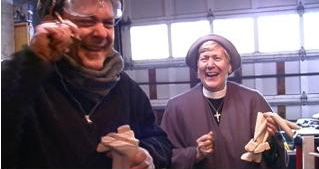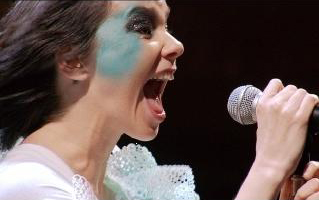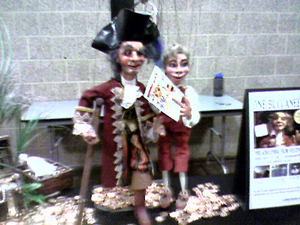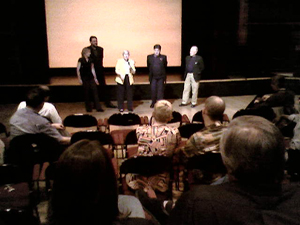Musings
an Online Journal of Sorts
By Alyce Wilson
April 4, 2006 - Sweet Masterpieces
Puppets
from Treasure Island,
on display in the theater lobby
On Sunday, The Gryphon and I saw two movies at the Philadelphia Film Fest, both of them documentaries.
The first one was at 7:30 at the International House on the University of Pennsylvania Campus. We ate first at a restaurant in the neighborhood called Mad Mex. It was a nice enough day that we could eat on the terrace. I ordered a vegan burrito, because it was the best way to indulge without going crazy. I figured that the whole wheat tortilla, soy sour cream, soy cheese and healthy fillings were a better choice than a regular burrito. As it turned out, it was really tasty, so I felt that I'd made a good choice.
They were playing 80s music on the sound system, which must have been like oldies music to most of the college age patrons.
Our first film of the evening was called One Buccaneer, directed by Jerry Greiner, Paul Hunt and Julie Kauffman of 3358 Films. The film is a documentary about the family-owned Hole in the Wall Puppet Theater in Lancaster. It follows the process of adapting the book Treasure Island to a one-man, nine-puppet production.
I was interested in this movie in part because I've had an interest in puppetry from a young age. My mom, an amateur artist, signed me up for a puppet workshop at the local YMCA when I was little, and we made everything from hand puppets to marionettes. The write-up about the film in the program guide also sounded interesting.
 The
movie starts out with master puppeteer, Robert Brock, showing how he makes
a puppet. Then the piece of wood goes flying off the sander and he curses
and picks it up. Immediately, you know it's not going to be a typically
dry documentary.
The
movie starts out with master puppeteer, Robert Brock, showing how he makes
a puppet. Then the piece of wood goes flying off the sander and he curses
and picks it up. Immediately, you know it's not going to be a typically
dry documentary.
Sure enough, the film is as much about the family behind the theater as about the production of the show itself. Every member of the family is interesting on screen, from the cheery, gregarious Robert to his soft-spoken Episcopalian deacon mother, Mary Lou, who handles all the business details. And then there's his outspoken, opinionated, funny father, Bob. The interactions between them are a joy to watch.
The family environment is one of good-natured ribbing, so that as the camera follows the behind-the-scenes process, it also documents the essential elements of this family: loving support, good-natured humor and perseverance.
In a number of on-camera interviews, Bob talks about his son. In one breath, he'll be critical about him: such as the fact that Robert doesn't have a head for practical matters and is a dreamer. Yet, he's also supportive of him and clearly loves his son.
Later in the film, he reveals that they almost lost Robert as a young boy because of a drastic neurological condition. A picture of a sweet-faced young Robert appears on screen, as Bob gets a little choked up. "He's a good man," he says. What a beautiful but natural depiction of a father's love.
For the most part, the documentary flowed really well, with editing used to underscore the verbal humor of the family's teasing. The only part I'd question is the choice to string together the documentary with sections of Robert reading the script for the play, in character as the nine different puppets. While it's impressive to listen to how he makes all the voices distinctive, it's hard to keep track of the action in the play without the visual aid of the puppets. After awhile, these portions just seem to distract from the more entertaining behind-the-scenes interactions between Robert's family and the other puppet theater volunteers.
The movie is gentle and uplifting, an inspirational story about family love and following your dreams.
Afterwards, the filmmakers gave a Q&A. As a pleasant surprise, they'd also brought Robert Brock and his mother, Mary Lou. Unfortunately, the father, Bob, passed away before the movie was completed. Robert thanked the filmmakers during the Q&A for capturing his father on film, who he said often stole the show with his dry humor.
Most of the audience wanted to ask Robert questions about his puppet theater. This is a good indication of how successful the documentary was, increasing interest in the subject.
I raised my hand and asked Robert if he'd ever considered doing voice work. He said that he didn't have enough time outside of the puppet theater, so he only did voice work for them. Then he dropped into a low, announcer voice and said, "This is my professional voice." Everyone laughed.
The last question of the evening was asked by a bright-eyed young boy who wanted to ask Robert how long it took to make a puppet. Perhaps in 20 years he'll be starting his own puppet theater somewhere.
I always enjoy seeing independent films at the Philly Film Fest, because more often than not, you get to meet the filmmakers in person and ask them questions. We had to get another film, so we took off right after the Q&A. Although I did congratulate the filmmaker and Robert himself on the way out the door. They were all being swamped.
 We
walked a few blocks to The Bridge, where we were going to see Screaming
Masterpiece (Gargandi Snilld). This documentary by Ari Alexander
Ergis Magnússon examines the musical scene of Iceland.
We
walked a few blocks to The Bridge, where we were going to see Screaming
Masterpiece (Gargandi Snilld). This documentary by Ari Alexander
Ergis Magnússon examines the musical scene of Iceland.
This film is almost more of a freewheeling festival than a documentary, as the filmmakers chose to let the music and the musicians speak for themselves.
The film opens with a sweeping aerial shot across the windswept, icy Icelandic landscape, and the head pagan of Iceland explains how integral music is to Iceland, as a way they've chronicled their history over the years. This sequence is underlay by sweeping music by one of the best known Icelandic bands, Sigur Rós. The film dissolves to a shot of them performing live on stage.
The movie sweeps forward with a similar feel, moving from one performance to another, from one place to another as musicians talk about Icelandic music. Portions of a 1981 documentary on the Icelandic music scene are cut in at parts, including images of a young Björk, looking very young.
The film includes a recent interview with and concert performance by Björk, where she talks about her musical goals and aspirations and how they apply to Icelandic music.
I got out my small notebook and took note of all the bands, hoping to track them down later. There are definitely some we'll be seeking out, such as Sigur Rós, Mugison, Bang Gang, Ghostigital, Múm, Quarashi, Slowblow and Amina.
According to the musicians interviewed for this documentary, Iceland is such a small country that it functions like one community. In one scene, the president of Iceland throws a house party with a young band providing the music! Can you imagine President Bush doing that?
The reason Icelandic music is so unique, more than one musician suggests, is because they feel that nobody is paying attention to them anyway, so they just make music however they want. The musicians often know and support each other, frequently jumping from group to group or performing in several bands at once.
In a country of only 300,000 people, one-third the size of New York City, there is an astounding number of bands, musical groups and musicians. Clearly, like the head pagan said, music is a fundamental part of Icelandic culture.
The film sweeps the viewer along with the force of the music, lots of beautiful landscape shots and some creative editing techniques, using dissolves and also the motif of an animated raven. The film is, truly, a screaming masterpiece.
Afterwards, we tried to go to the Marathon Grill again, but it was closed. So we walked down to a 24-hour diner right near the Cinema at Penn. I asked the waiter how big the sundaes were, and he said something like four scoops. So I asked for a single dip instead, which is the way it was listed in the menu. I expected one scoop of ice cream, and he brought me a huge chocolate sundae!
The Gryphon reminded me that I wasn't obligated to eat all of it just because the waiter made a mistake, so I only ate a little more than I would have if I'd received what I ordered. I have this compulsion, instilled at the family dinner table, not to waste food, but I've since come to see the wisdom of a college friend, who said that you eat too much food, you're still wasting it. It's just that the waste turns into fat, rather than garbage.
The ice
cream was tasty, and even though I felt guilty leaving a melting blob
of it behind, it was a tasty end to a sweet day.
More Musings from the 2006 Philadelphia Film Fest:
April 3, 2006 - Strange Desires
Musings on the 2005 Philadelphia Film Fest:
April 11, 2005 - Film Style 5+
Musings on the 2004 Philadelphia Film Fest:
April 12, 2004 - Indulging in Film
Moral:
Follow your artistic dreams, whether it's puppets or avant garde pop
music.
Copyright
2005 by Alyce Wilson
What
do you think? Share your thoughts
at Alyce's message board (left button):
![]()
![]()



